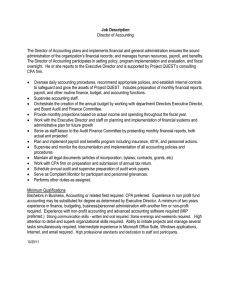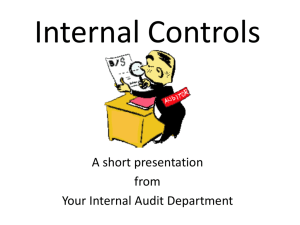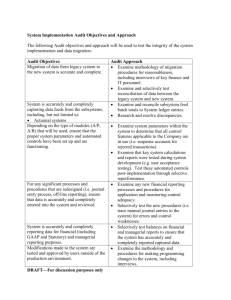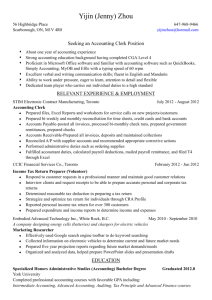Internal Controls– What are they and why should I care? Todd Stewart,
advertisement
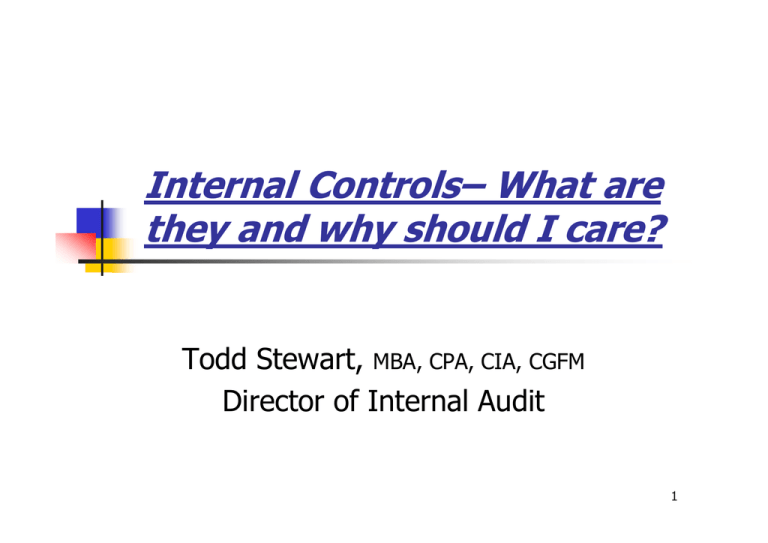
Internal Controls– What are they and why should I care? Todd Stewart, MBA, CPA, CIA, CGFM Director of Internal Audit 1 2 3 Course objectives Understand what internal control is and define the various types of internal controls. Gain an understanding of the “control environment”. Understand the types of controls you should have in place in your department and how we audit for those controls. Analyze case studies to understand the correlation between fraud and internal controls and what can happen when controls fail. Where to go for help. 4 What is Internal Control? Internal control is a process, effected by an entity’s board of directors (regents), management and other personnel, designed to provide reasonable assurance regarding the achievement of the following objectives: Effectiveness and efficiency of operations Reliability of financial reporting Compliance with applicable laws and regulations Safeguard assets 5 Internal Control Key Concepts Internal control is a “process”. It’s a means to an end, not an end in itself. Internal control is affected by “people”. It’s not merely policy manuals and forms, but people at every level of the organization. Internal control can be expected to provide only “reasonable assurance”, not absolute assurance, to an entity’s management and board. Internal control is geared to the achievement of the entity’s “objectives” . 6 Internal Control Key Concepts (cont.) Management, not auditors, must establish and maintain the entity’s controls No system can be regarded as completely effective Should be applied to both manual and computerized systems Are implemented to protect the employee 7 3 reasons for internal controls Protect the weak from temptation Protect the strong from opportunity Protect the innocent people from suspicion 8 Types of Internal Controls 1. 2. 3. 4. Directive Controls Preventative Controls Detective Controls Mitigating Controls 9 Directive Controls – encourage good behavior, it’s the right thing to do Incentive plans Recognition awards Training Policies and procedures Promotions 10 Preventative Controls – prevent undesirable events from occurring Knowledge that someone is reviewing your work Segregation of duties Limited access Levels of authorization Security badges Business rule set-up in automated systems 11 Detective Controls – detect and correct undesirable events after they occur. Reconciliations Auditing Confirmations Exception reports Reviews done on a regular basis 12 Mitigating Controls – Mitigate for the lack of an expected control. Cash handling – lack of adequate staff for proper segregation of duties – sharing with another area Software security/access – regular monitoring of access for certain employees when software security is not adequate because of functional constraints 13 Internal Controls can fail because: Employees can make mistakes or exercise poor judgment There can be collusion – where two or more individuals work together to misappropriate assets Management may inappropriately override established policies or procedures Employees are not held accountable No consequences for noncompliance 14 Implementing Internal Controls The cost of a control vs. the benefit derived is always a balancing act. It’s all part of the risk assessment. Remember though, not all controls will cost more money. 15 Risk Assessment – What is it? It’s a process to: Identify significant risks Assess risks Compliance/Financial/Operational What is the likelihood of occurrence? What is the potential impact? Manage these risks through: Avoidance Acceptance and sharing (insurance) Mitigate with internal controls 16 What are risks? A risk is anything that could jeopardize the achievement of your organization’s objective to: Achieve your goals Operate effectively and efficiently Protect the University’s assets (including employees) from loss Provide reliable financial data Comply with applicable laws, policies, and procedures 17 Identifying your risks Questions to ask yourself: What can go wrong? What laws or regulations would be violated? What policies most affect us? What types transactions/activities in our area expose us to the greatest risk? How can someone bypass the internal controls? (How could someone misappropriate assets?) What potential risks could cause adverse publicity? 18 What are control activities? Control activities are the policies and procedures that help ensure that actions identified as necessary to manage risks are carried out properly and in a timely manner. Policies should be implemented thoughtfully, conscientiously, and consistently. Procedures are not useful without a focus on policies 19 Key Control Activities Monitoring Control Environment Control Over Assets & Information Systems Segregation of Duties Authorization, Approvals, Verifications 20 Control Environment Ethical “tone at the top” communicated in words and deeds Ethics program, including meaningful code of conduct Active, independent, well-informed Board of Regents Organization structure appropriate to entity’s activities and which promotes the flow of information Clear definition of responsibilities and accountabilities 21 Control Environment (cont.) Analysis of knowledge and skills needed to perform each job; formal or information job descriptions; qualified and well-trained personnel Frequent interaction between senior and operating management. Appropriate policies and procedures for hiring, training, promoting and compensating employees Background checks for new hires, especially those in sensitive positions 22 What do we mean by “Tone at the Top” ? It’s Management’s behavior, control consciousness and commitment to competence by: Promoting integrity, ethical values & conduct Walking the walk Leading by example Being approachable Complying with policy Not circumventing policies & procedures Providing full disclosure Fixing problems Implementing equal treatment for equal offenses Rewarding things that are done right 23 Control Environment at the University of Iowa Implementation of a ‘Code of Business and Fiduciary Conduct’ which includes a specific section for senior management Composition of a ‘Resource Handbook for Business and Fiduciary Conduct’ http://www.uiowa.edu/president/ethicsconduct/handbook.htm ICON Course on Ethics and Responsibilities – go to your Portal page and then “My Training” and look for ICON courses This Business Process Series Training Opportunity 24 Control Environment at the University of Iowa (Cont.) Implementation of a confidential reporting mechanism for questionable financial behavior EthicsPoint is an independent third party contracted to receive reports of questionable financial activity Reports can be made by telephone or through the web Reports can be made anonymously All reports are forwarded to Internal Audit for triage and follow up 25 Control Environment at the University of Iowa (Cont.) The reporter is assigned an ID and password to sign into the system to track progress and answer questions Links are at the bottom of President’s Welcome page and on the Internal Audit home page http://www.uiowa.edu/president/ethicsconduct/index.htm http://www.uiowa.edu/~intaudit/ 26 Segregation of Duties Functions are divided so that no one person has control over all parts of a transaction. This reduces the risk of error or inappropriate action. Normally, the responsibilities of the following should be separated: Custody Recording Authorization Reconciliation Example: University cash handling policy 27 Rating yourself Do you provide management training for those who oversee others? What message do you send your personnel who travel regarding meal limits, conference meals that are included in the registration? What policies and procedures do you have in place for reporting vacation and sick leave? 28 Rating yourself (cont.) How well do you enforce annual employee evaluations? Do you have signature authority assignments or delegations in place that reflect a proper segregation of duties? What approval process do you have in place for transfers between accounts, for budgeting? 29 Authorizations/Approvals/ Verification Limit authorization authority ‘Delegation of Signature Authority “Rubber Stamping” ‘Responsibility of an Approver’ Secure access to passwords, electronic signatures or other signatory devices Develop written procedures outlining delegation guidelines 30 Authorizations/Approvals/ Verification (Cont.) Verify: Against an internal or external document Invoice Picture ID With other parties (NIH, SSA, Higher Ed Institution) NEVER sign a blank form!!! NEVER, NEVER, NEVER give your password NEVER, NEVER, to anyone!!! 31 Security of All Assets Even though this is a financially oriented presentation, please remember as you do your risk assessments, not all assets are financially focused. Children in PICU/NICU Academic & Research Data Human & Animal Research Subjects 32 Security of All Assets (Cont.) Periodic asset counts Periodic comparisons Investigation of discrepancies Regular data file backups Secure document retention (both hard copy & electronic) Physical safeguards against theft and fire 33 Monitoring Ongoing monitoring activities are Management’s responsibility Compares information about current performance to: Budgets Prior periods Other benchmarks (i.e. other peer universities) Measures against achievement of goals and objectives 34 Monitoring (cont.) Identifies unexpected results or conditions which require follow-up. The entire process must be constantly monitored, and make changes as conditions warrant. Separate evaluations are conducted by Internal Audit 35 Who is accountable for assurance that appropriate internal controls are in place? Management!!!! 36 Who’s responsible for the performance of internal control activities? Everyone!!!!!! 37 Audit tests, how well will your department do? Will your employees verify a strong tone of control (governance) when interviewed? Will your capitalized asset inventory be accurate? Will your budget controls and fund transfers have independent oversight and are they aligned with the purpose of the account charged? 38 How well will you do? (cont.) Are your purchases and disbursements properly approved and screened for university related purpose? How well are grants monitored for compliance? What is the involvement between the department and the PI? What best practices for IT controls are shared with employees? 39 How well will you do? (cont.) Are HR and Payroll on-line reports utilized to monitor the correct payroll? Are annual reviews performed? Are personnel files maintained? Are health related documents kept in a separate file? Are they secure? How is vacation and sick leave monitored? 40 How well will you do? (cont.) Does your IT area have good physical controls and is there a disaster/business continuation plan? Are employees’ access rights removed when they transfer or terminate? Are cash handling policies in place and are they followed? 41 IT Access Limitation Controls To create a record To change a record To approve a transaction By allowing read-only By requiring unique passwords Requiring time out limits By installing firewalls ITS desktop best practices 42 Control Tools (Partial Listing) Formal compliance programs Checklists Inspections Exception reports (i.e. Performance appraisals not completed, excessive overtime, duplicate payments etc.) Forms control (pre-numbered documents, filing by and verifying integrity of numerical sequence) Performance standards Physical safeguards (safes, locks, access cards, dual control over sensitive assets, cameras, alarms, guards, ID badges etc.) Simulated disaster recovery drills 43 Which of the following are examples of an internal control? Segregation of duties Passwords Bonus plans Reconciliations Staff Meetings Training on a new system Training in group dynamics Directions on how to complete expense reports Requiring original receipts for expense reports Managers accurately completing their own expense reports Managers telling employees to be scrupulous in completing their expense reports Standard price lists, with sales people allowed a maximum of 10% variance for negotiation 44 What happens when internal controls fail? Loss of revenue Non-compliance Loss of reputation Negative impact on students/patients/staff OR 45 FRAUD!!! 46 Fraud Fast Facts • • • • • Annual estimated fraud losses: $994 billion Most fraudsters are first-time offenders Amount of loss is directly related to fraudster’s position in the organization Most frauds are detected by tips Deterrence is key Source: ACFE’s 2008 Report to the Nation on Occupational Fraud and Abuse 47 Fraud Triangle Opportunity (or perceived opportunity) Need (Financial Problems) Rationalization 48 Red Flags for Fraud No vacation Voluntary overtime Unexplained variances Complaints No reconciliation One employee “does it all” Documentation is not original “Rush” requests 49 Detection of Fraud • • • • • • 46% 20% 19% 23% 9% 3% Tips Discovered by accident Internal Audit Internal controls External audit Notified by police Source: ACFE’s 2008 Report to the Nation on Occupational Fraud and Abuse 50 If you suspect fraud…. Do Not confront the person Do Not talk about it with co-workers Do Not try to verify fraud has taken place or catch them on your own. DO call Departmental or College Administrators, Internal Audit, University Counsel, or University Police – Experts in objective verification of the facts Work closely with University Counsel and Safety/Security to document the issues with possibility of testifying in court. 51 52 Facts of the case Opened unauthorized checking account to maintain “coffee funds” Unauthorized account used to deposit subscriptions, travel reimbursements, copy reimbursements, etc Approx. $7,000 of University funds diverted from unauthorized account to personal account Procurement card in her name used to purchase furniture that never showed up in the department 53 Facts of the case continued….. Procurement card reconciliation with furniture purchase was approved by supervisor Procurement card reconciliations were always late Forged signatures of different staff members on University vouchers Discovered by call from Credit Union asking about University checks being deposited into personal account 54 What controls failed…… Violated various policies including… checking account creation cash handling expense reimbursement processing No segregation of duties No account reconciliations No monitoring by management Department allowed the creation of a checking account 55 56 Facts of the case Manager of vending services pled guilty for stealing over $12,000 in cash from token operated vending machine operation. Students would pay cash for tokens but not all the cash was deposited and token inventories were not reconciled. Discovered when another person who counted the money noticed missing bags of money from one day to the next. 57 What controls failed….. No proper segregation of duties No account reconciliations No inventory reconciliations Cash not safeguarded 58 59 Facts of the case Misrepresented her credentials… Resume noted a Bachelors, two Masters, and a Ph.D. when in fact she had not earned any degree. Added her name on a scholarly article when she was not an author Received funds from the NIH to pay for a post-doctoral program even though she had not earned a doctorate 60 Facts of the case (cont.) Filed fraudulent travel reimbursements Claimed up to 880 mi. per day to visit research subjects when she didn’t visit them at all Many weeks she filed for trips taken 7 days in a row Filed for trips taken when she also filed vacation or sick leave time Filed for expenses taken for a trip on Thanksgiving Day which was in the middle of a string of 10 straight days of trips Total reimbursement over an 18 month period totaled $53,000 and 215,000 miles 61 Facts of the case continued….. University had to reimburse NIH several thousand dollars for the grant she was involved with Detected when other employees became suspicious about her credentials When things don’t always “seem” right there are often good reasons 62 What controls failed….. No monitoring by management Inadequate approval and verification Inadequate control environment 63 Des Moines Register February 2, 2009 Audit: UNI official improperly spent money A state audit report has identified more than $19,400 in apparent improper disbursements and unrecorded personal leave taken by an official with a University of Northern Iowa program 64 Facts of the case Assistant Director, Camp Adventure, UNI Campus Personal purchases on PCard for travel for herself and a friend 21 days of unrecorded personal leave Travel advance not repaid January 1, 06 to March 31, 2008 65 Facts of the case (cont.) Administration person left - was behind on reconciling PCard statements Reported to her Director that she had inadvertently used University Card and started making repayments Over 7,000 minutes of personal calls on University cell phone 66 What controls failed….. Late PCard Vouchers No independent review of PCard No review of leave records by supervisor Cell phone policy Travel advance policy not followed 67 Other instances of control failures University Parking Clinic personnel using free parking passes for their own use University Student Health Clerk allegedly crediting her own account 68 Internal Control Quiz 1. Which of the following is NOT a true statement? a. Putting controls in place will always cost more money b. Controls help to ensure compliance with policies c. Controls will help the organization achieve its mission d. Controls will help protect the organization’s assets 69 2. The most important component of internal control is: a. Segregation of duties b. Following policies c. The integrity, ethical values, and competence of an organization’s employees d. Theft prevention 70 3. Who has the primary responsibility for internal controls in your college/department? a. b. c. d. The The The The college dean/department chair college/department fiscal officer Internal Audit Department Controller 71 4. Segregating duties is most important because: a. An employee should not be put in a position where they are able to “steal & conceal” b. Having too many duties overburdens an employee c. The auditors may write you up if you don’t do it d. All of the above 72 5. Which is NOT an example of an internal control? a. b. c. d. Maintain adequate records Combine recordkeeping and custody of assets Apply IT controls to your work environment Make deposits daily or per policy 73 6. Which of the following is true regarding internal controls? a. Are only needed to keep dishonest people from stealing b. Are not needed in a small office where everyone knows each other c. Are not needed if the staff is honest d. Are always necessary regardless of the staff involved 74 7. The fiscal officer of the School of DeArts wants to make sure the controls that were implemented are still effective. The fiscal officer should: a. Ask all of the other school fiscal officers if they have had any money stolen b. Change the locks on the doors c. Spot-check transactions, records, and reconciliations to ensure they meet expectations d. Ask for an Internal Audit of the school’s internal controls 75 8. The fiscal officer for the School of LearningStuff is trying to decide the best way to process payroll for their ten non-exempt (hourly) lab techs who work for the school’s only researcher. Which of the following ideas would have adequate controls? a. Each employee would fill out their time card, compute total regular and overtime hours, then give it to the school secretary for input into the system. b. Each employee would fill out their time card, then give it to the school secretary who would calculate hours and input it into the system. c. The school secretary would keep track of lab tech hours, compute total hours and input them into the system. d. All of the above contain adequate controls. e. None of the above contain adequate controls. 76 9. One critical element in the internal controls of any department or college is: a. b. c. d. Background checks for all employees Level of education of staff Integrity and ethics of the chair or dean The number of policies and procedures 77 10. No matter how well designed and executed, internal controls can fail because: a. Employees can make mistakes or exercise poor judgment b. There can be collusion – where two or more individuals work together to steal c. Management may override established policies or procedures d. All of the above 78 11. You have accepted a position whose duties include the role of fiscal officer for several departments in your school. One of you first decisions is to delegate your signature authority and the review of the payroll reports for fiscal transactions to an approver for one of the departments. Of the list of potential candidates, who should you NOT choose to be an approver? a. The account manager for the department b. Administrative support staff who have no payroll processing duties c. Administrative support staff who are payroll processors d. Administrative support staff who have no payroll processing duties but who are outside of the department e. You would not choose a, c, or d from the above 79 What can Internal Audit do for you? Give you free expert advice Benchmark with your peers Assist with specific issues within the area Provide training on internal controls Provide a confidential sounding board for your ideas or concerns Help identify risks in your areas. 80 Thank you for your time today. Questions? University Internal Audit W512 Seashore Hall E613 General Hospital http://www.uiowa.edu/~intaudit/ christopher-delsandro@uiowa.edu debra-johnston@uiowa.edu 81

